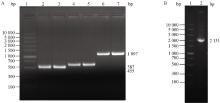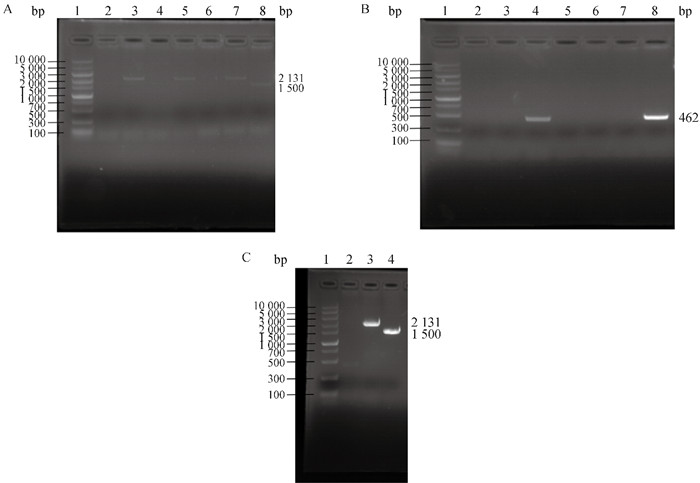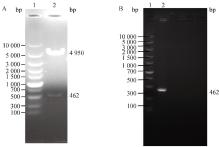





Acta Veterinaria et Zootechnica Sinica ›› 2025, Vol. 56 ›› Issue (10): 5104-5114.doi: 10.11843/j.issn.0366-6964.2025.10.030
• Preventive Veterinary Medicine • Previous Articles Next Articles
WU Tingting1( ), GUAN Feihu1, GUO Jia1, ZHANG Lu1, ZHU Dexin1, SUN Zhihua1, CAO Shuzhu1, XU Yimei2, ZHANG Hui1,*(
), GUAN Feihu1, GUO Jia1, ZHANG Lu1, ZHU Dexin1, SUN Zhihua1, CAO Shuzhu1, XU Yimei2, ZHANG Hui1,*( ), DENG Xingmei1,*(
), DENG Xingmei1,*( )
)
Received:2025-01-13
Online:2025-10-23
Published:2025-11-01
Contact:
ZHANG Hui, DENG Xingmei
E-mail:1599077290@qq.com;prof.zhang@foxmail.com;deng_0216@163.com
CLC Number:
WU Tingting, GUAN Feihu, GUO Jia, ZHANG Lu, ZHU Dexin, SUN Zhihua, CAO Shuzhu, XU Yimei, ZHANG Hui, DENG Xingmei. Construction of Brucella Secretory Protein BPE005 Deletion Strain and Its Effect on GPR126/ADGRG6 Protein[J]. Acta Veterinaria et Zootechnica Sinica, 2025, 56(10): 5104-5114.
Table 1
Primer information for PCR amplification of genes"
| 基因 Genes | 引物序列(5′→3′) Primer sequences | 产物大小/bp Pruduct size | 退火温度/℃ Annealing temperature |
| BPE005-N (上游同源臂) | F: 5′-CCGGAAATCAACCCGAAAT-3′ R: 5′GACATTCATCCCAGGTGGCTCTTCTCAATCCAGATCGAAAGTCGC-3′ | 455 | 56 |
| BPE005-C (下游同源臂) | F: 5′-TCTGGGGTTCGAAATGACCGGAGTTGTCAATACACCTGCATCGG-3′ R: 5′-AATGGCATAGTGGACCTTCTCA-3′ | 583 | 56 |
| Kan | F: 5′ GCCACCTGGGATGAATGTC-3′ R: 5′ CGGTCATTTCGAACCCCAGA-3′ | 1 097 | 60 |
| BPE005 | F: 5′-GGCGCTAGACGACGATATTC-3′ R: 5′-CCTGCTCGATCTGGCCGATA-3′ | 462 | 60 |

Fig. 1
PCR amplification and fusion of upstream and downstream homology arms of BPE005 gene and kanamycin-resistant fragments A. Amplification of fragments (1. DNA marker; 2, 3. BPE005 upstream homology arm detection; 4, 5. BPE005 downstream homology arm detection; 6, 7. Kangene detection); B. Fusion of fragments (1. DNA marker; 2. BPE005 fusion fragment)"


Fig. 2
Validation of BPE005 gene deletion strain of S2308 A. PCR fragment of S2308△BPE005 using BPE005 external primers (1. DNA marker; 2-7. Detection of the BPE005 deletion strain; 8. Detection of 2308 strain); B. PCR fragment of S2308△BPE005 using BPE005 special primers (1. DNA marker; 2-7. Detection of the BPE005 deletion strain; 8. Detection of 2308 strain); C. Verification of of S2308△BPE005 (1. DNA marker; 2. Use BPE005-specific primers to detect BPE005 deletion strains; 3. Use BPE005 external primers to detect BPE005 deletion strains; 4. Use BPE005 external primers to amplify the S2308 fragment)"


Fig. 3
Validation of S2308 BPE005 recyclable strain A. double enzyme digestion of pBBR1MCS4-BPE005 (1. DNA marker; 2. pBBR1MCS4-BPE005 double enzyme digestion detection); B. Detection of BPE005 replenishment strain using BPE005 specific primers (1. DNA marker; 2. Detection of the BPE005 replenishment strain)"

| 1 |
KHAN M Z , ZAHOOR M . An Overview of brucellosis in cattle and humans, and its serological and molecular diagnosis in control strategies[J]. Trop Med Infect Dis, 2018, 3 (2): 65.
doi: 10.3390/tropicalmed3020065 |
| 2 |
WU Z G , SONG Z Y , WANG W X , et al. Correction: Human brucellosis and fever of unknown origin[J]. BMC Infect Dis, 2023, 23 (1): 23.
doi: 10.1186/s12879-023-07986-7 |
| 3 | 谢士杰, 彭小薇, 冯宇, 等. 布鲁氏菌逃避宿主免疫机制的研究进展[J]. 生命科学, 2019, 31 (9): 871- 878. |
| XIE S J , PENG X W , FENG Y , et al. Mechanism of Brucellaevading from host immune response[J]. Chinese Bulletin of Life Sciences, 2019, 31 (9): 871- 878. | |
| 4 |
ZHENG M , LIN R , ZHU J , et al. Effector proteins of type Ⅳ secretion system: Weapons of Brucellaused to fight against host immunity[J]. Curr Stem Cell Res Therap, 2024, 19 (2): 145- 153.
doi: 10.2174/1574888X18666230222124529 |
| 5 |
ZHANG J , LI M , LI Z , et al. Deletion of the type Ⅳ secretion system effector VceA promotes autophagy and inhibits apoptosis in Brucella-infected human trophoblast cells[J]. Curr Microbiol, 2019, 76 (4): 510- 519.
doi: 10.1007/s00284-019-01651-6 |
| 6 | BYNDLOSS M X , TSAI A Y , WALKER G T , et al. Brucella abortus infection of placental trophoblasts triggers endoplasmic reticulum stress-mediated cell death and fetal loss via type Ⅳ secretion system-dependent activation of CHOP[J]. mBio, 2019, 10 (4): e01538- 19. |
| 7 | DE JONG M F , STARR T , WINTER M G , et al. Sensing of bacterial type Ⅳ secretion via the unfolded protein response[J]. mBio, 2013, 4 (1): e00418- 12. |
| 8 |
ARRIOLA BENITEZ P C , REY SERANTES D , HERRMANN C K , et al. The effector protein BPE005 from Brucella abortusinduces collagen deposition and matrix metalloproteinase 9 downmodulation via transforming growth factor β1 in hepatic stellate cells[J]. Infection and immunity, 2016, 84 (2): 598- 606.
doi: 10.1128/IAI.01227-15 |
| 9 |
TORREGROSA-CARRIÓN R , PIÑEIRO-SABARÍS R , SIGUERO-ÁLVAREZ M , et al. Adhesion G protein-coupled receptor Gpr126/Adgrg6 is essential for placental development[J]. Sci Adv, 2021, 7 (46): eabj5445.
doi: 10.1126/sciadv.abj5445 |
| 10 | 邱润辉, 关飞虎, 陶婷婷, 等. 布鲁氏菌分泌蛋白BPE005的亚细胞定位及与宿主细胞互作蛋白的筛选[J]. 中国畜牧兽医, 2022, 49 (4): 1438- 1448. |
| QIU R H , GUAN F H , TAO T T , et al. Subcellular localization and screening of host interacting proteins of Brucellasecreted protein BPE005[J]. China Animal Husbandry & Veterinary Medicine, 2022, 49 (4): 1438- 1448. | |
| 11 | COHEN L J , KANG H S , CHU J , et al. Functional metagenomic discovery of bacterial effectors in the human microbiome and isolation of commendamide, a GPCR G2A/132 agonist[J]. Proc Natl Acad Sci U S A, 2015, 112 (35): E4825- E4834. |
| 12 |
XING X L , YUAN X T , LIU T T , et al. Regulatory region mutations of TERT, PLEKHS1 and GPR126 genes as urinary biomarkers in upper tract urothelial carcinomas[J]. J Cancer, 2021, 12 (13): 3853- 3861.
doi: 10.7150/jca.56779 |
| 13 |
BARQUERO-CALVO E , CHAVES-OLARTE E , WEISS D S , et al. Brucella abortus uses a stealthy strategy to avoid activation of the innate immune system during the onset of infection[J]. PloS one, 2007, 2 (7): e631.
doi: 10.1371/journal.pone.0000631 |
| 14 |
O'CALLAGHAN D . Novel replication profiles of Brucella in human trophoblasts give insights into the pathogenesis of infectious abortion[J]. J Infect Dis, 2013, 207 (7): 1034- 1036.
doi: 10.1093/infdis/jit010 |
| 15 |
DENG X , HE J , WANG Y , et al. Deletion of the type Ⅳ secretion system promoter VirB in Brucella abortus A19 strain attenuated the virulence of the bacteria and promotes autophagy[J]. Can J Microbiol, 2022, 68 (3): 165- 176.
doi: 10.1139/cjm-2021-0053 |
| 16 | 张孟涛, 戴恩慧, 孙东杰, 等. 布鲁氏菌Ⅳ型分泌系统效应因子调控宿主细胞功能研究进展[J]. 微生物学通报, 2025, 52 (2): 533- 544. |
| ZHANG M T , DAI E H , SUN D J , et al. Progress in the regulation of host cell functions by Brucella type Ⅳ secretion system effectors[J]. Microbiology China, 2025, 52 (2): 533- 544. | |
| 17 | 史静雪. 布鲁氏菌分泌蛋白VceA和VceC对细胞自噬和凋亡的影响[D]. 石河子: 石河子大学, 2017. |
| SHI J X. Secretion proteins VceA and VceC of Brucella effects on autophagy and apoptosis[D]. Shihezi: Shihezi University, 2017. (in Chinese) | |
| 18 |
MARCHESINI M I , HERRMANN C K , SALCEDO S P , et al. In search of Brucella abortustype Ⅳ secretion substrates: screening and identification of four proteins translocated into host cells through VirB system[J]. Cell Microbiol, 2011, 13 (8): 1261- 1274.
doi: 10.1111/j.1462-5822.2011.01618.x |
| 19 | 吴婷婷, 贾思齐, 曹树珠, 等. 黏附类G蛋白偶联受体GPR126/ADGRG6的结构与功能[J]. 生物化学与生物物理进展, 2025, 52 (2): 299- 309. |
| WU T T , JIA S Q , CAO S Z , et al. Structure and function of GPR126/ADGRG6[J]. Progress in Biochemistry and Biophysics, 2025, 52 (2): 299- 309. | |
| 20 |
PICCHIANTI-DIAMANTI A , SPINELLI F R , ROSADO M M , et al. Inhibition of phosphodiesterase-4 in psoriatic arthritis and inflammatory bowel diseases[J]. Int J Mol Sci, 2021, 22 (5): 2638.
doi: 10.3390/ijms22052638 |
| 21 |
MUSSEN F , BROECKHOVEN J V , HELLINGS N , et al. Unleashing spinal cord repair: The role of cAMP-specific PDE inhibition in attenuating neuroinflammation and boosting regeneration after traumatic spinal cord injury[J]. Int J Mol Sci, 2023, 24 (9): 8135.
doi: 10.3390/ijms24098135 |
| 22 |
LI Z , WANG S , HAN J , et al. Expression of cytokine and apoptosis-associated genes in mice bone marrow-derived macrophages stimulated with Brucella recombinant type Ⅳ secretion effectors[J]. Cytokine, 2024, 182, 156711.
doi: 10.1016/j.cyto.2024.156711 |
| 23 |
PEREZ-GARCIA V , FINEBERG E , WILSON R , et al. Placentation defects are highly prevalent in embryonic lethal mouse mutants[J]. Nature, 2018, 555 (7697): 463- 468.
doi: 10.1038/nature26002 |
| 24 | LI Q , HUO A , LI M , et al. Structure, ligands, and roles of GPR126/ADGRG6 in the development and diseases[J]. Gen Dis, 2024, 11 (1): 294- 305. |
| 25 | 瞿向利. 黏附类G蛋白偶联受体的结构与功能研究[D]. 上海: 中国科学院大学(中国科学院上海药物研究所), 2022. |
| QU X L. Structural and Functional studies of adhesion G protein coupled receptors[D]. Shanghai: University of Chinese Academy of Sciences, 2022. (in Chinese) | |
| 26 |
MORIGUCHI T , HARAGUCHI K , UEDA N , et al. DREG, a developmentally regulated G protein-coupled receptor containing two conserved proteolytic cleavage sites[J]. Genes Cells, 2004, 9 (6): 549- 560.
doi: 10.1111/j.1356-9597.2004.00743.x |
| 27 |
KAKOGIANNOS N , SCALISE A A , MARTINI E , et al. GPR126 is a specifier of blood-brain barrier formation in the mouse central nervous system[J]. J Clin Invest, 2024, 134 (15): e165368.
doi: 10.1172/JCI165368 |
| [1] | QIN Yi, HU Wenjie, FANG Xiaowei, GUO Qian, TIAN Lanxin, LIU Fang, FANG Chun. Effect of Deletion of the Lipoteichoic Acid Synthase ltaS Gene on the Pathogenicity of Listeria monocytogenes [J]. Acta Veterinaria et Zootechnica Sinica, 2024, 55(2): 670-679. |
| [2] | ZHANG Duo, TENG Man, ZHANG Zhuo, LIU Jinling, ZHENG Luping, GE Siyu, HAN Fang, LUO Qin, CHAI Shujun, ZHAO Dong, YU Zuhua, LUO Jun. Development and Pathogenicity Analysis of a meq-gene-edited Candidate Marek's Disease Vaccine Strain Generated from a Hypervirulent MDV Variant [J]. Acta Veterinaria et Zootechnica Sinica, 2024, 55(12): 5672-5683. |
| [3] | Ting YOU, Shanhui REN, Meng WANG, Hongqiang ZHANG, Xiaolong GAO, Wei YAO, Hui WANG, Xue YANG, Chunling MA, Minyi LIU, Yuzhe ZHANG, Jinlong WANG, Yuefeng SUN, Haotai CHEN, Guirong WANG. Construction and Replication Ability of the ORF112 Gene Deleted Orf Virus Strain [J]. Acta Veterinaria et Zootechnica Sinica, 2024, 55(11): 5200-5210. |
| [4] | HE Shufan, ZOU Yuantong, HUANG Zhilan, LI Qian, JIANGCUO Wengxi, YUE Hua, TANG Cheng, LIU Jie. Detection of Bovine Adenovirus Type 3 Infection Status and Its Fiber Shaft Gene [J]. Acta Veterinaria et Zootechnica Sinica, 2023, 54(3): 1333-1340. |
| [5] | YANG Fuchun, LIU Rui, LI Xiaohan, GAO Li, LIU Changjun, QI Xiaole, CUI Hongyu, WANG Xiaomei, GAO Yulong, LI Kai. Construction of UL41 Gene Deletion Strain of Duck Enteritis Virus and Analysis of Its Replication Ability in vitro [J]. Acta Veterinaria et Zootechnica Sinica, 2022, 53(8): 2689-2696. |
| [6] | DU Jige, ZHAO Wei, PENG Guorui, LI Qianlin, YIN Chunsheng, YAO Wensheng, ZHANG Xiukun, YANG Liu, FU Lizhi, CHEN Xiaoyun, LIU Ying. Expression and Immunogenicity of No-toxin Recombinant Clostridium septicum α Toxin [J]. Acta Veterinaria et Zootechnica Sinica, 2021, 52(1): 202-209. |
| [7] | HUANG Hui,LIU Bao-guang,SUN Ya-wei,MA Cai-hui,CHEN Li-peng,YUAN Li,PAN Yu-shan,HU Gong-zheng. Construction of cpxR and acrB Double Gene Deletion Strain of Salmonella enterica Serovar Typhimurium and Analysis of Its Susceptibility to Antibacterial Agents [J]. ACTA VETERINARIA ET ZOOTECHNICA SINICA, 2016, 47(3): 595-602. |
| [8] | CHEN Zi-meng,DONG Xuan,SU Shuai,CUI Ning,LI Zhuo,CUI Zhi-zhong. Identification and Sequence Analysis of Endogenous Avian Leukosis Virus Element in Genome of Hy-Line Brown Layers [J]. ACTA VETERINARIA ET ZOOTECHNICA SINICA, 2015, 46(11): 2050-2055. |
| [9] | LI Hongguang;WANG Fang;JIANG Ping;FAN Zhiyu;HU Bo. Construction of Defined Mutations of PRN of Rabbit Bordetella bronchiseptica and Property Research [J]. ACTA VETERINARIA ET ZOOTECHNICA SINICA, 2012, 43(2): 299-305. |
| [10] | ZHENG Min;LIU Qi;JIN Ningyi;SHI Kaichuang;LIANG Yuan;MO Shenglan;QU Sujie;LU Wenjun;HU Bo . Construction and Identification of the Recombinant Goatpox Virus with ORF8—ORF18 Deleted [J]. ACTA VETERINARIA ET ZOOTECHNICA SINICA, 2010, 41(1): 65-70. |
| [11] | SUN Qing-jie;LIU Xue-wei;LI Yi-jing. Construction and Characterization of Avian Pathogenic Escherichia coli Mutant with fimC Gene Deletion Mutation [J]. ACTA VETERINARIA ET ZOOTECHNICA SINICA, 2009, 40(5): 730-737. |
| [12] | YANG Xiao-nong;GUO Wan-zhu;XU Zhi-wen;ZHU Ling;WANG Xin;ZENG Xiu;WANG Xiao-yu. Study on Pathogenicity and Immunogenicity of ORF3 Gene Deleted Mutational Strain of Porcine Circovirus Type 2 to Piglets [J]. ACTA VETERINARIA ET ZOOTECHNICA SINICA, 2008, 39(8): 1094-1099. |
| Viewed | ||||||
|
Full text |
|
|||||
|
Abstract |
|
|||||